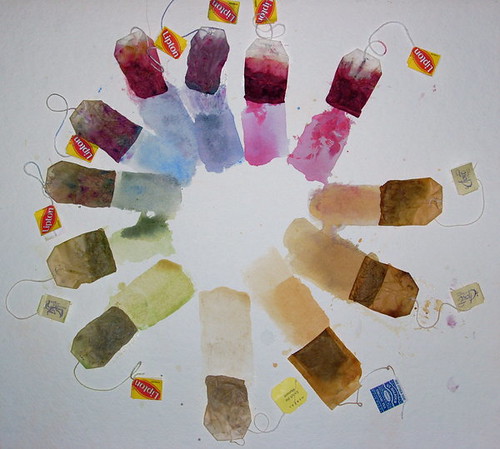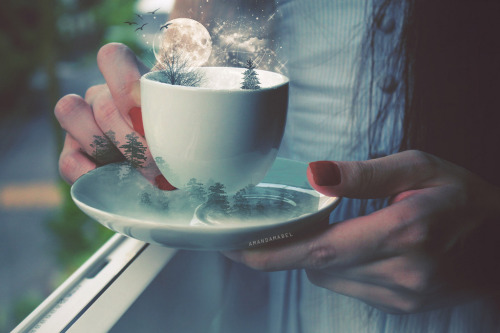subtle interventions on the Behance Network
the first explorations in Creaiv-@T....
Friday, 29 July 2011
Friday, 22 July 2011
Wednesday, 20 July 2011
Tuesday, 19 July 2011
Monday, 18 July 2011
Arty Bollocks Generator
Instant artist statement: Arty Bollocks Generator
http://www.stumbleupon.com/to/s/1keGdh
http://www.stumbleupon.com/to/s/1keGdh
I sold a picture
cant belive i sold a picture, i didnt think ti was worth it on da but i thought nothing much can go wrong might ern a little, i got $0.10 way, ok so its crap but i feel all warm inside!?!? woop
more ideas
i have been starting at my previous post trying to think of something to write, and i have. maybe a new creation a modern tea cermony/performance peice.
with a new kettle, all my mugs on the wall, and a selection of friends to come and join me, being allocated a mug, one that will be assoated with them and told the asoatied story with mug. then ask them if they have any stories they would wish to share. record all. possible do a silent run with only kettle noises. sit on tea crates and use them as tables.
serve tea made with tea bag in ask parteicepnt to trow bag at the wall, and there mug will me mounted underneeth it.
catchy thing jsut came to mind
death of the saucer, tea stain and coat a saucer then smash it, leave it when it fall, photograph
with a new kettle, all my mugs on the wall, and a selection of friends to come and join me, being allocated a mug, one that will be assoated with them and told the asoatied story with mug. then ask them if they have any stories they would wish to share. record all. possible do a silent run with only kettle noises. sit on tea crates and use them as tables.
serve tea made with tea bag in ask parteicepnt to trow bag at the wall, and there mug will me mounted underneeth it.
catchy thing jsut came to mind
death of the saucer, tea stain and coat a saucer then smash it, leave it when it fall, photograph
Friday, 15 July 2011
basics of tea cermony
Tea Ceremony
| Cha-no-yu (the tea ceremony) or Sadô (lit. the way of tea) was introduced to Japan from China and perfected by Master Sen-no-Rikyu based on the spirit of Zen in the 16th century. | |
 | |
| For Japanese people, cha-no-yu is a mental discipline for pursuing "wabi" (a state of mind in which a person is calm and content, with a profound simplicity) and is at the same time a performance in which form and grace are paramount. | |
 | |
| A ceremonial tea-room is usually about three meters square (a four-and-a-half tatami-mat room) and is decorated very simply. The spirit of "wabi" is exemplified by this tea-room. | |
 | |
| Nijiri-guchi: a side door about 60 cm square through which guests enter the tea-room. Since they are forced to bow when passing through this door, they naturally lose their sense of self-importance and become humble. | |
| The style of cha-no-yu depends on the school, such as Ura-Senkê, Omotê-Senkê, etc. The style described above is primarily that of Ura-Senkê. |
@T
No negativ@T,
just creative@T!
With small festiv@T And lots of productiv@T,
some selective@T with a new new activ@T,
But not radioactive@T,
Nor captiv@T
just creative@T!
With small festiv@T And lots of productiv@T,
some selective@T with a new new activ@T,
But not radioactive@T,
Nor captiv@T
mea tea?
Meat Tea Cup
- 0
inShare

Food art, specifically those dealing with meats, definitely tiptoe a fine line of amazing and disgusting. It is art nonetheless. With this piece, the Meat Tea Cup, we bring you coverage of a past a contemporary art exhibition entitled Meat After Joy. The entire show is made up of sculptures, photography, painting and video pieces “in order to investigate the paradoxical relationship meat has to the body.”
another links post
http://www.gio.gov.tw/taiwan-website/5-gp/culture/art_tea/
http://www.manybooks.net/titles/hoovertother10Zen_Culture.html
http://www.artoftea.com/learn_about_tea/
http://www.alanwattsarchive.com/chanoyu.html
do a ott macro shoot with tea tea bags, hinting a stories spilling out
Thea Proctor's tea party 1924 (detail) Art Gallery of New South Wales, purchased 1942

http://www.manybooks.net/titles/hoovertother10Zen_Culture.html
http://www.artoftea.com/learn_about_tea/
http://www.alanwattsarchive.com/chanoyu.html
do a ott macro shoot with tea tea bags, hinting a stories spilling out
Thea Proctor's tea party 1924 (detail) Art Gallery of New South Wales, purchased 1942

Getting into the head of Twinings Tea | CreativeRoots - Art and design inspiration from around the world


 What a fun student project this must have been to redesign the well established Twinings Tea packaging. Most of you most probably picked up at least once in your life a Twinings tea. You may also thought that they look a little conservative. That’s exactly what the three design students from the Portfolio Center in Atlanta, Chris Yoon, Jess Gerjets, Peter Smith thought.
What a fun student project this must have been to redesign the well established Twinings Tea packaging. Most of you most probably picked up at least once in your life a Twinings tea. You may also thought that they look a little conservative. That’s exactly what the three design students from the Portfolio Center in Atlanta, Chris Yoon, Jess Gerjets, Peter Smith thought.The team wanted get into the heads of Twinings Tea to see if there was any chance of branching out to a younger demographic (young adults, working professionals). Using Twinings most famous tea’s Prince of Wales, Earl Grey and Lady Grey they got inspired by dry British humor and vibrant colours which front the packaging. The concept was to “get into the head” of each character, and so the cylindrical container lifts off, revealing a joke printed on each tea bag.
Do you think these students deserve a 1st?
Tuesday, 12 July 2011
Sunday, 10 July 2011
Tea scrolls
'esence of tea' scroll
This elegant tea scroll was painted by tea master Wu De, an American who has lived in Asia for a number of years. Adept at Chinese brush painting, he applies his gifts to the subject of tea, making his scrolls appropriate for any tea room, whether at home or in public.The tea scroll features the rustic yet elegant brushstrokes of a teapot balanced perfectly on the peak of a mountain. The accompanying calligraphy reads: "The Essence (or Nature) of Tea Is Qi" The artist's signature and stamp or "hanko" resides in smaller script below and to the left of the calligraphy, and another of the artist's stamps is in the lower left corner of the piece.
The brush painting is mounted on reddish brown silk with a silk bow-tied hanger at the top and the bottom weighted by carved wooden dowel. Entire scroll, including silk mount measures 48" x 17.75" Sent in tube
 |
Tea Paintings
Tea Paintings: The Birds
by Nancy Lucas

The Birds

The Birds

The Birds
Tea Paintings
by Cassatt, Matisse & Pollock
In this month's installation of the Art of Tea, we'll do a quick study of the development of art through the interpretation of tea. We'll cover three pieces by great artists from different periods, including Mary Cassatt, Henri Matisse and Jackson Pollock. While the art varies greatly from the earlier to the later pieces, each artist was equally inspired by this great beverage.

1919 - Tea
Henri Matisse was a painter, sculptor and lithographer. Along with Picasso, Matisse is considered one of the two foremost artists of the modern period. His contribution to 20th-century art is inestimably great.
Henri Matisse was a painter, sculptor and lithographer. Along with Picasso, Matisse is considered one of the two foremost artists of the modern period. His contribution to 20th-century art is inestimably great.

1946 - The Tea Cup
Jackson Pollock, generally known as the primary figure in the Abstract Expressionism movement, was famous for splattering or dripping paint on a canvas. Like Adagio Teas, Jackson Pollock's work has appeared in Time Magazine.
Tea Sculptures and photography
by Eric M. Sternfels

High Pour: Allergenic
Eric M. Sternfels' work springs from a sense that inanimate objects possess their own soul and history. When speaking about the pieces he collects for his work, the artist believes the energy of those that designed or made them, of those that have used and enjoyed them, and of those that now take the time to see them again in new light all collaborate to give us pleasure and satisfaction.
View additional examples at: www.pourtensious.com
http://www.teamuse.com/article_060803.html
Tea Photography: Tea Cup From Hilda
by Marcy L. Dewey

Tea Cup From Hilda
Marcy photographs are mostly of things botanical or inanimate objects. She love high-contrast lighting, both in B&W and color photos. Marcy rarely work with a flash, as sunlight is her favorite source of lighting.
http://www.teamuse.com/article_060603.html
Michelle Brody, Tea Art
by Christine Rillo

The Teacart Under the Bridge

The Tea House

Used Tea Filters as Works of Art
Michele Brody first premiered her unique installtion during last year's Annual DUMBO Art Under the Bridge Festival in form of a portable 'tearoom'; a food vendor's push-cart familiar to the streets of New York City. The tea cart is borrowed from a food vendor she befriended outside her work and is large enough to hold an assortment of teas and teaware, as well as the artist and a companion. For the festival, she stationed her tea cart in the Brooklyn neighborhood and invited many a passerby to come into her tea cart and have a cup of tea with her. Using a recording device, Michele records their conversation, as she asks them She then saves the paper filter used to steep their tea in, dries and irons them, and transcribes their conversation- along with the date and type of tea they enjoyed- onto the filter with ink. In a variation of this project the artist has constructed a 'teahouse' out of gleaming copper pipes, using the dried paper filters to construct walls; a colorful tapestry due to the various stains of the different teas she serves. The tearoom represents a structure similar to those used in Japanese tea ceremonies, where a specific structure is built for the sacred ritual.
Michele also takes care in preparing her tea for her new friends. She is well-stocked with a variety teas donated by local NYC tea establishments, Sympathy for the Kettle and Alice's Tea Cup. The guest will pick out their tea, as well a piece of unique teaware (along with teas from around the world, her teaware reflects many different styles from traditional British china to simple and sublime cups from China). Michele wishes to represent with her diverse selection of teas and teaware the multicultural aspect of taking tea. Tea is a very important tradition throughout the world, whether it be taking part in a serene Japanese tea ceremony or gussying up for afternoon tea in Britain.
Along with the theme of multiculturalism, Michele hopes to represent the immigrant experience. Her use of the push-cart conjures up images of newly arrived immigrants in New York, hoping to make their way in a new country, many taking up the business of food vending. This can also be tied to modern-day, where many of New York's food vendors are recent transplants to America, who along with serving the typical American street food- hot dogs, pretzels, roasted nuts, introduce native dishes like Shish-kebobs and dosas. For future tea cart installations, Michele hopes to work with historical societies in neighborhoods whose roots lie within the immigration influx of the turn of the century.
Tea House Products hopes to also negotiate the juxtaposition of our modern fast-paced, impersonal American 'to go' culture with the intimate, private, and personal. By inviting strangers to join her in her tea cart or tea house, and asking about their day, interests, background, and their thoughts on and memories of tea, she hopes to create a personal experience for all the participants, as well as taking the time to slow down and enjoy a cup of tea, through it's preparation represents the practice of patience in order to achieve the perfect tasting cup.
Michele hopes to bring the show throughout the country as well as put together a book with the various musings of her participants complete with photographs of the installations. Michele Brody's next installment will take place on June 5th through the 7th at the Henry Street Settlement Art Center on the Lower East Side in NYC. If you find yourself in the area, wander by, and perhaps Michele will invite in for some tea.
Please visit Michele Brody's website for more information on and pictures of Tea House Productions and to view other installations and works of art the artist has accomplished.
http://www.teamuse.com/article_080501.html
Tea and Art: Jeff Axelrod
by Christine Rillo

Art by Jeff Axelrod
 Art by Jeff Axelrod
Art by Jeff Axelrod  Art by Jeff Axelrod
Art by Jeff AxelrodAxelrod grew up in Massachusetts and after getting in and out of trouble at a number of schools, he picked up and moved out to Cape Cod where he worked slavishly at 3 jobs and finished school on his own. He describes this time as a period where it wasn’t an admirable trait to be artistic; it was considered being rebellious and not with the norm. His artistic inclinations did not form just yet however.
It started when Axelrod moved to the Big Apple, New York City. With a small family to support, he opened and operated a gas station and parking lots in the heart of Midtown Manhattan. With the bustling city around him, he began to open up. After his family moved back to the quiet of Cape Cod, he stayed on to manage the businesses. While living in the city still, he was able to explore arty Greenwich Village; the haven for such souls. Galleries beckoned to him from Chelsea, cafes in the Village and it became his new scene.
Midway through the 60s, he closed the family business and moved out to San Francisco, a city with the similar free-spirit vibe New York’s Village had to offer. Many friends agreed he would be a good fit. He then started a silk-screening business and found himself printing tee shirts for the Grateful Dead and partying. At the end of the 70s, he sold his business, tired of the lifestyle and competition overseas markets and hit the road traveling and discovering the country only to be brought back to Sausalito.
In his new home, he found that he was inspired to create. In his old business he had to work through designers who produced the imagery for shirts; as he states, “I used to live through their hands”. Surrounded by the natural and earthy vibe of his new home he turned to a very natural ingredient- tea, which he uses to paint the backgrounds. He utilizes ‘assemblage’ on top of the paint: the art of gluing ornaments and objects. Elements of collage are also evident in his work.
His tea painting takes on a particular process. He takes a variety of loose leaf tea and brews them in series of 15-20 clear glass jars, this way he can see what colors he comes up with. He states that half of the fun is watching what color he will end up with. From there he mixes colors to make his paints, which is similar to water colors. However, he thinks that he gets better color with his tea paints, then anything he could get from basic watercolors.
Though many may think that his pallet of colors is limited, there is a surprising amount of colors he has discovered. Berry and plum fruit teas make for purples and blues, matcha produces a green color, rooibos for orange, chai mixtures for a range of browns. He paints a base of tea color on papers with earth tones as a backdrop and lets it bake out in the warm sun- this prevents any sort of fading. From there he will continue to apply paint, or add his ornaments and found objects. Most of his objects are finds from garage sales, on the street, from friends, from his travels, and artifacts from his childhood. His works are then multi-dimensional and reflect a variety of themes. His works remind me of beautiful vintage ephemera, a bit of arts and crafts, and bright sunshine. He is inspired by his surroundings in Sausalito- the roll of the fog, living by the water, and glimpses of scenic views.
In his search for different teas to experiment with, Axelrod began to embark on a mini campaign to put in requests with various tea companies for samples of their teas. A friend advised him of the annual World Tea Expo, the tea industry’s largest gathering and he was relieved not to have to put so many letters in the post. At the expo he met with many companies and met other tea enthusiasts, along with our company, Adagio Teas. He finds that the tea industry is way easier and a lot nicer to work with than those in his past industry of apparel. He is also thrilled that many were receptive to his art and it has served to be a fodder of inspiration.
As for tea to drink, Axelrod grew up on black tea with lots of milk and sugar and it wasn’t until he moved to California that he discovered the wide variety of teas. At first he would set aside his tea to supply the inventory for his paint, but as he came into more and more, he happily drinks and paints away with a diverse selection of teas.
If ever in Sausalito, you will probably see Jeff Axelrod’s work hanging in various cafes and restaurants. He has also had his work on display in various galleries in the city and at the annual Sausalito Art Festival.
Please visit Jeff Axelrod’s website for information on how to purchase his works as well as view more images of his paintings.
http://www.teamuse.com/article_091101.html
Tea & Steam: An Industrial Revolution
by James Norwood Pratt



Black tea of the Assam variety became a standardized, industrial-strength commodity. The English author and occultist Aleister Crowley studied Buddhism in Ceylon in 1906. "There seems to be something in the climate," he remarks in his Confessions, "that stupefies the finer parts of a man if he lives there too long. The flavor of the tea seemed to me somehow symbolic. I remember one day pleading with the local shopkeeper to find me some Chinese tea. It chanced that the owner of a neighboring plantation was in the shop. He butted in, remarking superciliously that he could put in the China flavor for me. 'Yes,' I said, 'but can you take the Ceylon flavor out?"'
Such tea snobs were simply overwhelmed; between 1860 and 1914 the only investments in the British Empire more profitable than tea estates were South African gold and diamond mines. British working people were urged to "buy Empire" black teas. Most of these were designated not by leaf type-pekoe, souchong-or origin-Keemun, Bohea-but by brand name: Mazzawattee, Brooke Bond, Ty-phoo, Liptons and Lyons, the tea shop brand.
It's hard to understand why nobody in England thought of the tea shop before 1884, but nobody did. The first was a space in a bakery near London Bridge, and the idea caught on. There are things English people like to do in the absence of the opposite sex (through no lack of love, to be sure), but drinking tea is not one of them. This accounts for the phenomenal success of the Lyons chain of tea shops, which became a national institution overnight, and ever since the British have found it impossible to imagine a time when the tea shop did not exist.
In response to mass merchandizing and advertising, the British increased their consumption of (heavily sweetened) tea steadily right through World War I, and their counterparts in the British dominions followed suit. Australia absorbed tea at the astonishing rate of 7.7 pounds per capita in 1899; U.S. per capita consumption reached its highest point in 1897 at 1.56 pounds. Europe's tea consumption soared also, especially in Russia. Moscow's most famous literary teahouse steeped thirty-three pounds of tea daily-almost six tons a year!
China's peak year for tea exports was 1886; Russia received 27 percent of that total, half the amount of Great Britain but twice that of the United States. Following the Opium Wars, Russian capitalists had set up their own brick tea factories in Hankow in 1861 and gradually gained control of brick tea manufacturing throughout China. The caravan trade went on growing in volume right up to 1880, when the first link of the Trans-Siberian Railroad was opened. With the completion of the railway in 1900, the caravans passed into history, finally returning Usk Kayakhta to the obscurity it so richly deserves. The tea that had formerly required many months to reach Russian samovars made the trip by rail in seven weeks.
Two innovations that revolutionized tea habits and the tea industry in the U.S. date from the first decade of the twentieth century. The first may be traced to the St. Louis World's Fair of 1904, the one the song "Meet Me in St. Louis" was written for. Most of the tea drunk in America at that time came from China, and in the Midwest, for reasons that have never been entirely clear to me, people drank mostly green teas. To popularize Indian tea, therefore, an association of India tea producers established a special pavilion at the fair, staffed with exquisitely mannered and beturbaned Indian servers under the supervision of an Englishman named Richard Blechynden. The scorching Midwestern summer gives New Delhi competition in the Fahrenheit category, however, and Blechynden's exotic, steaming brew was the last thing the sweltering fair-goers felt like sampling. Before long Blechynden himself began sweating, for there was no unemployment compensation at the time, and in his desperation began pouring his tea into glasses crammed with ice just to get people to drink it. People drank it. They came back for more and carried the liking for it back home with them. Thus was born a new American drink - iced tea.
Though uncommon in other countries, the United States is drinking almost fifty billion glasses of iced tea a year as compared to ten billion cups of hot. It takes over two hundred million pounds of tea to fill those cups and glasses each year. That under 5 percent of this amount is now sold as loose tea is due to a second accidental innovation, the tea bag.
In 1908, a New York City tea importer named Thomas Sullivan made an effort to economize on his operating costs by sending samples out to his retail dealers and private customers in little silk bags sewn closed by hand. He was perplexed but delighted when virtually everybody placed orders. Only when they all complained that the tea he delivered wasn't packaged those bags for convenience in steeping, did he get the idea to substitute gauze for the silk and rake in sizable profits, producing the first tea bags. Expensive and elaborate machines and special papers or fibers are used today, but this development, like instant tea, has more to do with business administration and international finance than with the present history. At best tea bags compromise tea quality; most are contemptible, and many beneath contempt. I offer no cringing apologetics for lowest-common-denominator tea: I drink it too. Iced tea and tea bags, made for the most part with tea dust and fannings rather than full leaves, have their place in modern American life, I ungrudgingly acknowledge; the point I'm making is that even the poorest peasant in the homeland of tea would feel entitled to better.
Tea in Art: Artist Mithun Jayaram
by Christine Rillo

Pages from his tea notebook

Piece with dried tea pieces and other material

Drying tea

A finished piece
"I had never been to a place that dealt with vast subtleties of the tongue, throat, and nostrils, "Jayaram states when experiencing fine tea before. "I've never liked tea prior...I've always had the impression that tea was to be served as a standard milk and ultra sweet drink."
He took to becoming a tea drinker rather quickly (white tea is his favorite) while visiting Infinitea before and after his classes, realizing that tea was indeed full of flavor sans sugar and milk. Pot after pot was drunk and as he became more aware of the different flavor nuances that each particular tea exuded; his curiosity also grew concerning the actual tealeaf. As an artist, this feeling wasn't anything new, and these used tea leaves at the bottom of his teapot sparked inspiration and creativity.
Mithun Jayaram was born in Kerala, India and raised in Dubai, UAE. His initial interest during high school was that to the science of genetics and didn't expect himself to be interested in art. He fell into art unexpectedly; having gone the science route, he wasn't doing too well in chemistry and at the same time an adviser chose Mithun to represent his class in an art competition. A drawing of a dinosaur being pushed over a cliff by a bulldozer won him first place in the competition and the head judge encouraged him to pursue art.
After his initial education was completed, he left Dubai for the likes of LaSalle College of Arts in Singapore pursuing a bachelor's degree in fine arts. He finished his studied in 2004 after graduating with honors and was awarded a fellowship to study and do research in Romania. From there he continued on to work with award winning artists in Europe and Singapore on group exhibitions. Life brought him back to the country of his birth, this time in Bangalore, where he is currently producing art and studying French.
Mithun began to take out the leaves after drinking his tea and placing them in his notebook. From there he began to take note to how they dried and what colors, forms, textures, and traces they would leave behind as they soon became refuse. He would smell the leaves when wet and dry. Mithun states a very personal process goes into exploring the tealeaves, as well as anything else that is of interest to him.
Mithun's art uses all sorts of other material that we may deem as refuse, but he sees as providing many possibilities. This includes cotton, matchsticks, pencil shavings, and tissues. He is very much influenced by the environment around him and observes what he uses and throws away, fascinated by these items' provisional existences: "I tend to select material that I recognize as a by product/product of my routine". Along with that Jayaram likes to use unconventional materials to make 'temporary' pieces , displaying them in unconventional spaces not usually considered as a formal art space. This use of alternative material and viewing spaces for his art provides a type of connection for Jayaram; a type of meditative state and his art becoming products of this particular sense of being. Along with his note taking on the physical form the tea leaves take upon drying, he likes to record the effect on tea on his body versus when he consumes coffee, understand the way tea affects him, and his well-being.
The Lost Tea Leaves Series and the use of tealeaves in his art hold a special place among his various projects. In a sense, it is a very kind of 'Green' living accord that Jayaram takes from using the tea leaves: it is the first material that is true refuse from someone else, and not from his immediate use. His intensive record keeping on the way that the tealeaves dried and developed caught the eyes of the owners of Infinitea, Gaurav Saria and Deeksha Saria who became his unofficial mentors on the ins and outs of gourmet tea. The husband and wife tea-team educated Mithun about tea history and culture and were more than happy to provide their 'tea trash' to Mithun, which he collects every couple of days or so. He happily separates the leaves of use to him, then he dries them using two different methods - under the sun or by a fan inside his home, each producing different results. Lumps of tealeaves resemble charred pits on the patio of his home where he dries the tea leaves. Mithun also observes the way the weather may affect the dried tea leaves and how the effect of time serves the tea leaves. In a true circle-of-life kind of way, the tea leaves that he doesn't uses goes into his father's garden for fertilizer.
"The final piece is not that important to me, the process is though. I find that the process of making something reveals a fertile ground of possibilities from which more works can branch," notes Jayaram. This series includes both photographs of the different ways the tea leaves dry as well as the art pieces created by using the leaves.
In May, Mithun was able to put some of his work on display where it all began, at Infinitea for a small show featuring several finished pieces. Mithun hopes to develop his love of tea further, as well as go visit a tea plantation in the future to fully understand the process of plant to cup. He also plans on continuing his extensive records of tea's composition and decomposition as an on-going project. Mithun Jayaram is able to pull inspiration from anywhere- movies to mundane activities and frequently posts photos and such on Facebook to share with friends, a bit of an online exhibition.
At least with this latest material of tea leaves will keep him drinking and inspired, "I still enjoy coffee but not as much as I do white tea. The sensations I get from them are quite extraordinary at times."
gryphon tea heritage art
Posted by Camemberu | Posted in gourmet tea | Posted on Saturday, May 08, 2010 
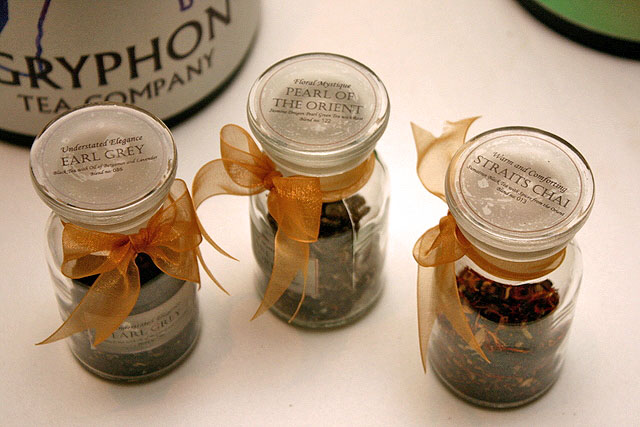
Gryphon Tea has launched its Heritage Art Series, a special initiative to help promote awareness of Singapore's history and give exposure to local young artists. It's supported by the National Heritage Board (NHB).
Lots of companies give support to the arts and culture, but I got the feel that Gryphon Tea's founder and director Mr Lim Tian Wee is truly passionate about the arts (well, his own father was an artist). At the launch event last month, he spoke with great enthusiasm about this labour of love that he championed.
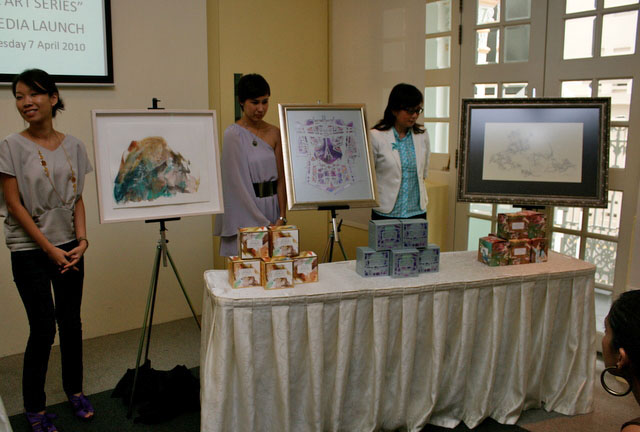
What Gryphon Tea did was identify three budding artists (yes, all three just happen to be female) and commission them to freely create their interpretation of how Singapore's heritage inspires them. The NHB gave the artists full access to its museums.
The designs were then parlayed into special edition boxes for three tea blends. These are quite pretty. Take a look.
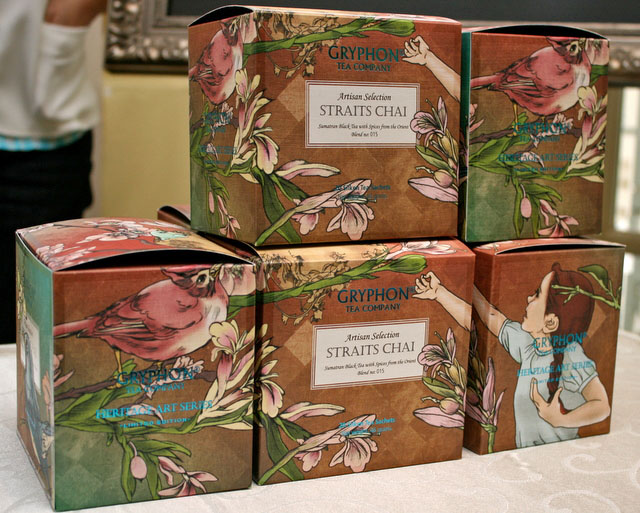
Artist Lee Wai Leng (also known as FleeCircus) created this whimsical piece "Beneath the Cardamom Shade" depicting the carefree innocence of a child in a garden. She drew inspiration from the Singapore Art Museum and its large collection of Asian contemporary art. Her artwork adorns the Straits Chai tea box.
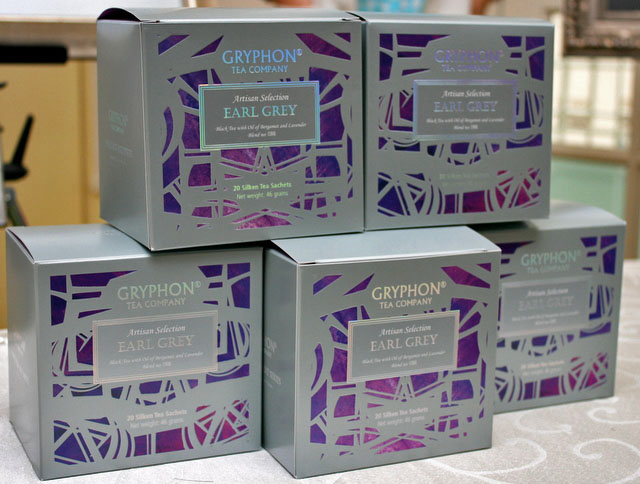
Gryphon's Earl Grey tea has gone futuristic with Annette Heitmann's silver and lilac paper-cut multi-layer artwork called "Earl Grey 2053". Annette used the letters in the name "Earl Grey" to create a face representing Earl Charles Grey (to whom the tea owes its name). She also included aspects of symmetry and modern design found at the National Museum of Singapore.

The Peranakan museum inspired Wyn-Lyn Tan with its intricately designed Baba and Nyonya crockery. She incorporated the green, pink, yellow and brown she saw to represent the green tea, rose and jasmine elements within her favourite tea, The Pearl of the Orient. Her piece entitled "Blush of a Golden Hue" combines graphite pencil lines with freeform Chinese ink brushstrokes.
All three boxes of tea are packed together in one set, along with a card that gives a pair of admission tickets to any one of the three museums that the artists drew inspiration from. The set retails at S$60 (before GST), and there are only 2,000 sets distributed in Singapore, Malaysia, Indonesia, and Vietnam.
For a list of retail locations, call Gryphon Tea at +65 6779-2948.
The good news is - I have five of these Heritage Art Series sets to give away! Just name any one of the artists and the tea blend they chose. First five to answer correctly will win. Please check back here for results, and be on standby to give me your real name and email address so I can arrange for you to collect your limited edition set.
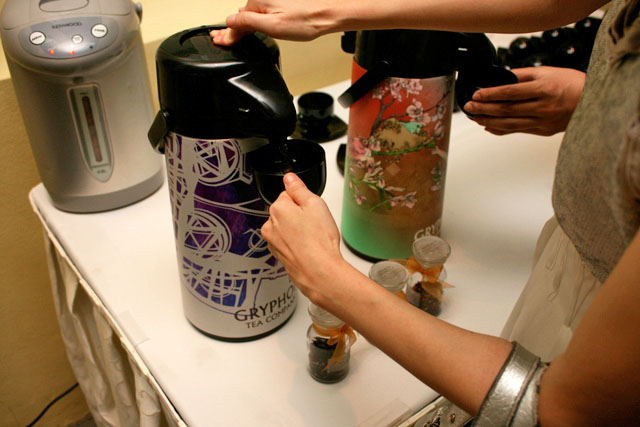
I like the artwork they created for Gryphon. Quite frankly, I would happily get me one of these hot water air pots with the designs if they sold them!
Subscribe to:
Posts (Atom)







